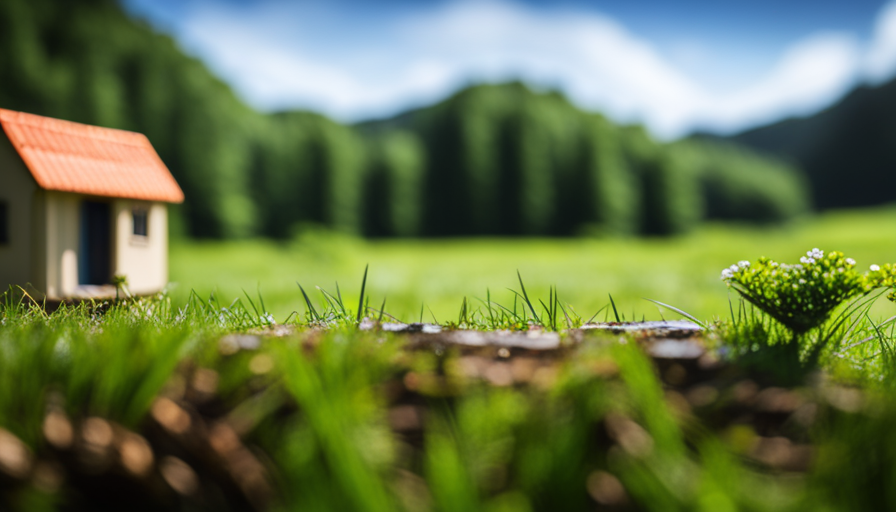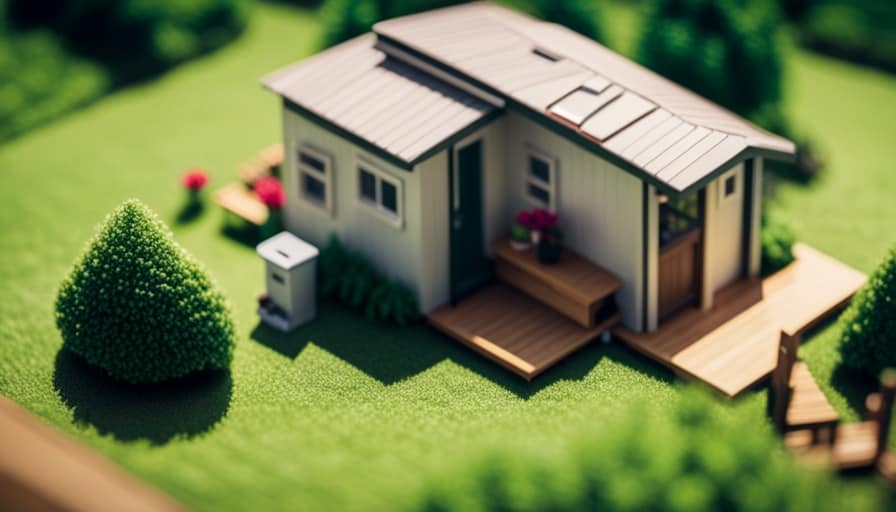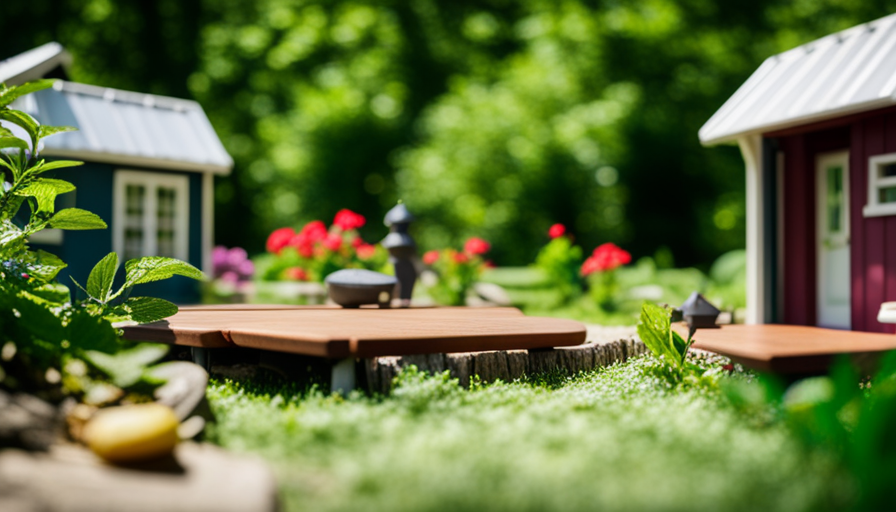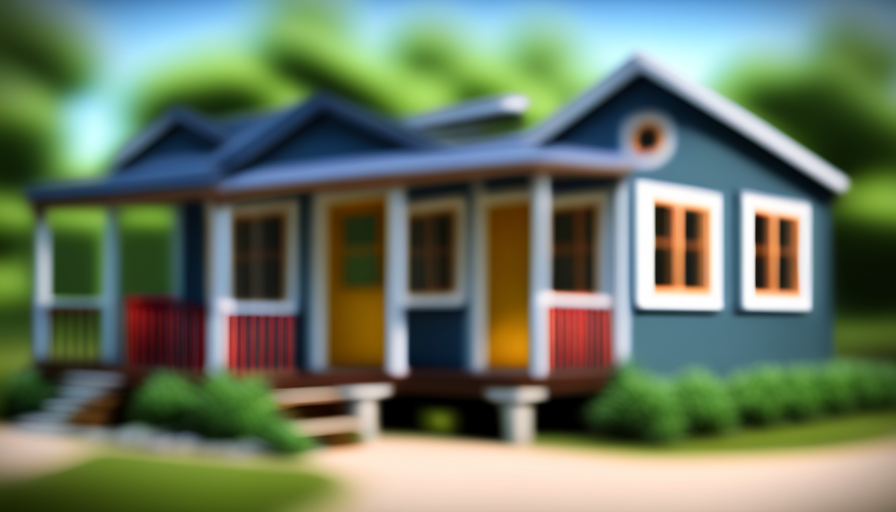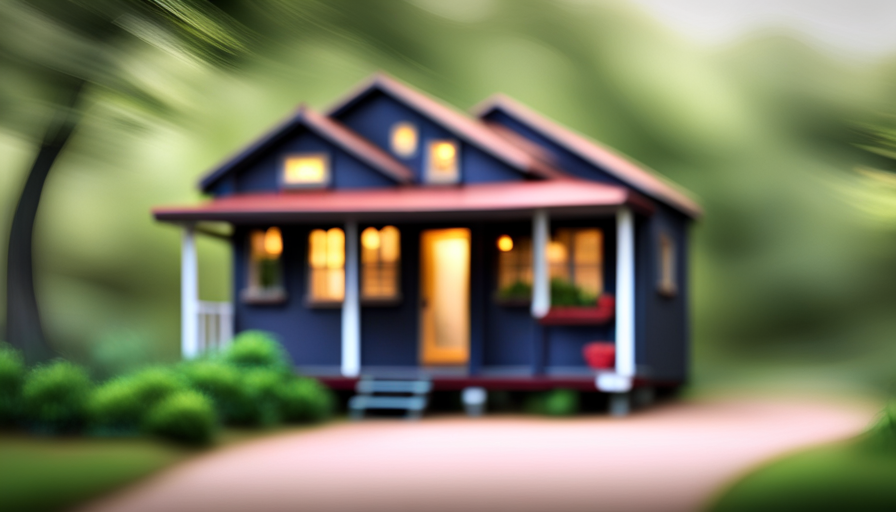Starting the journey of building a tiny house involves carefully analyzing several important factors, with the budget for land being one of the most crucial. Searching for the perfect location to place your small dream home can seem like a daunting task, similar to finding a needle in a haystack. Rest assured, I am here to help you navigate through this intricate process. In the upcoming article, we will explore the intricacies of effectively budgeting for land, providing you with valuable information and tools to help you make informed decisions.
From researching zoning regulations and permits to calculating annual property taxes, we will leave no stone unturned. Additionally, we will delve into the world of infrastructure and utilities, as well as consult with real estate agents and land specialists.
So, grab a pen and paper, because by the end of this article, you will have a comprehensive budget plan that will pave the way to your tiny house dreams.
Key Takeaways
- Budgeting for land is crucial for building a tiny house.
- Researching zoning regulations and permits is essential.
- Comparing rural and urban areas can provide insight into different costs.
- Additional costs like property taxes, utilities, and permits should be factored in.
Consider the Location of the Land
When planning to build a tiny house, it’s crucial to consider the location of the land you choose. Conducting a thorough location analysis is essential to ensure that the land meets your specific needs and requirements.
Factors such as proximity to amenities, accessibility, and the overall neighborhood should be taken into account. Additionally, it’s important to assess the availability of land in your desired area. Depending on the location, land prices can vary significantly, so it’s essential to budget accordingly. Researching land availability will help you determine whether you can find a suitable plot within your budget.
Once you have identified potential locations, the next step is to research zoning regulations and permits, which will be discussed in the subsequent section.
Research Zoning Regulations and Permits
While researching zoning regulations and permits, it’s important to consider the specific requirements for your desired location. Each city or municipality has its own set of regulations and guidelines for building a tiny house. Here are three crucial factors to consider:
- Setbacks and Clearances: Research the minimum distance required between your tiny house and property lines, neighboring structures, or any natural features. This will determine how much space you need for your tiny house and its surrounding area.
- Land Use Restrictions: Some areas have restrictions on the use of land, such as prohibiting residential buildings or limiting the number of structures on a single property. Understanding these restrictions is essential to ensure your tiny house plans align with local regulations.
- Permitting Process: Research the process for obtaining permits, including the necessary paperwork, fees, and inspections. This will give you a clear understanding of the timeline and costs involved in the regulatory process.
Considering these requirements and obtaining the necessary permits will help you navigate the process smoothly. Determining the size of the land needed for your tiny house comes next.
Determine the Size of the Land Needed
Next, it’s crucial to figure out the amount of space required for your dream home. To determine the size of the land needed, you should consider various factors such as the number of rooms, desired amenities, and outdoor space requirements. Conducting a size estimation is essential to ensure that your tiny house fits comfortably on the land you choose. It’s advisable to create a detailed floor plan and consult with an architect or builder to accurately calculate the space needed. Additionally, a cost analysis should be conducted to estimate the expenses associated with acquiring the land of the required size. This includes considering the location, accessibility, and infrastructure availability. By carefully considering these factors, you can determine the appropriate size of land and budget accordingly. Moving forward, it is important to research land prices in different areas to find the most affordable option for your tiny house project.
Research Land Prices in Different Areas
To find the perfect spot for your dream home, start exploring various areas and compare the prices of available land options. Research market trends to determine the fair price range for land. By comparing rural and urban areas, you can gain insight into the different costs associated with each location.
When researching land prices, it’s important to consider the emotional aspect as well. Picture yourself waking up to a breathtaking view of the countryside or being surrounded by the vibrant energy of a bustling city. These emotions can help guide your decision-making process.
Additionally, take into account the potential for appreciation in value. Land in up-and-coming areas may be more affordable now but could see significant growth in the future.
Factor in additional costs such as property taxes, utilities, and necessary permits. By considering all these factors, you can create a comprehensive budget for your dream tiny house project.
Factor in Additional Costs
Don’t forget to account for the various expenses that come with your dream home, such as property taxes, utilities, and permits, which can add up and potentially blow your mind. When budgeting for land, it’s important to factor in additional costs and hidden expenses that may arise. These can include site preparation, landscaping, and the installation of utilities like water, electricity, and sewage systems. You may also need to consider the cost of hiring professionals such as architects, engineers, and contractors. To give you an idea of the potential costs involved, here is a table that breaks down some common additional expenses you might encounter:
| Additional Costs | Estimated Range |
|---|---|
| Site Preparation | $2,000 – $10,000 |
| Landscaping | $1,000 – $5,000 |
| Utilities | $5,000 – $15,000 |
| Professional Fees | $5,000 – $20,000 |
| Permits | $500 – $2,000 |
Considering all these factors, it’s important to carefully plan and budget for these additional expenses when determining how much to spend on land. After accounting for these costs, you can then consider financing options to make your dream of building a tiny house a reality.
Consider Financing Options
When considering financing options for purchasing land for a tiny house, it’s important to explore mortgage loans as a potential avenue. This can provide the opportunity to secure a loan with favorable terms and interest rates, allowing for more flexibility in budgeting for the land.
Additionally, seller financing or land contracts should be considered, as they can offer alternative options for financing the purchase of land without the need for a traditional bank loan.
Look into Mortgage Loans for Land
Consider exploring mortgage loans for land to help you secure the perfect plot for your tiny house without breaking the bank. When it comes to financing options for land, mortgage loans are a popular choice. They allow you to borrow money from a lender and repay it over time, usually with interest. This can be an effective way to spread out the cost of purchasing land, making it more affordable and manageable for your budget.
To give you an idea of what to expect, here is a table outlining some common mortgage loan options and budgeting strategies:
| Mortgage Loan Options | Budgeting Strategies |
|---|---|
| Conventional Mortgage | Save for a Down Payment and Closing Costs |
| FHA Loan | Consider a Low Down Payment Option |
| USDA Loan | Explore Rural Development Loans |
| VA Loan | Take Advantage of Veteran Benefits |
| Adjustable-Rate Mortgage | Consider Short-Term Budget Flexibility |
By considering these mortgage loan options and budgeting strategies, you can make an informed decision about financing the land for your tiny house. In the next section, we will explore seller financing or land contracts as another potential option for securing your dream plot.
Explore Seller Financing or Land Contracts
After researching mortgage loans for land, I discovered another option worth exploring: seller financing or land contracts.
With seller financing, the seller acts as the lender, allowing buyers to make payments directly to them instead of obtaining a traditional loan from a bank. This can be a great alternative for those who may not qualify for a mortgage or prefer a more flexible arrangement.
Land contracts, on the other hand, involve the buyer making payments directly to the seller over a set period of time, with the seller retaining ownership until the contract is paid in full.
Both options have their advantages and considerations, such as negotiating the terms of the agreement and understanding the risks involved. Exploring these alternatives can provide a pathway to securing the land needed for your tiny house.
Now, let’s delve into how to calculate annual property taxes.
Calculate Annual Property Taxes
To accurately budget for your tiny house project, you’ll need to factor in the annual property taxes that will tug at your heartstrings. Calculating property taxes can be a complex task, as it involves researching property assessment methods and determining the property value. To help you understand this process better, I have prepared a table outlining the property tax rates for different property values in our area:
| Property Value | Property Tax Rate |
|---|---|
| $50,000 | 1.5% |
| $100,000 | 2.0% |
| $200,000 | 2.5% |
| $300,000 | 3.0% |
| $500,000 | 3.5% |
By using this table and estimating the value of the land you are considering, you can calculate an approximate amount for your annual property taxes. Once you have this information, you can proceed to assess infrastructure and utilities for your tiny house project. This will ensure that you have a comprehensive understanding of all the costs involved in your endeavor.
Assess Infrastructure and Utilities
Don’t forget to take a moment and imagine the possibilities as you assess the infrastructure and utilities for your cozy haven.
When evaluating the infrastructure, consider the existing roads, bridges, and pathways that lead to the land. Are they well-maintained and easily accessible?
Additionally, assess the availability and quality of utilities such as water, electricity, and sewage systems. Are these services readily available or would you need to invest in installing them?
Evaluating the infrastructure and utilities is crucial as it directly impacts the cost and feasibility of building your tiny house. It’s important to thoroughly research and understand the existing conditions to avoid any surprises or additional expenses down the line.
By assessing utilities and evaluating infrastructure, you can make an informed decision about the land’s suitability for your tiny house project. This will ensure a smooth and cost-effective construction process.
As you complete this assessment, consider consulting with a real estate agent or land specialist for further guidance and expertise.
Consult with a Real Estate Agent or Land Specialist
Consider enlisting the expertise of a real estate agent or land specialist to receive valuable guidance on your cozy haven project. These professionals are well-versed in the real estate market trends and can provide valuable insights into the availability of land suitable for building a tiny house.
Here are a few key points to consider when consulting with a real estate agent or land specialist:
- Market Analysis: They can conduct a market analysis to identify areas where land is more affordable and readily available.
- Zoning Regulations: They can guide you through the zoning regulations specific to tiny houses, ensuring that you choose a location where building permits are feasible.
- Land Pricing: They can provide information on land pricing in different areas, helping you determine a realistic budget for purchasing the land.
- Property Assessment: They can assess the infrastructure and utilities available in different areas, helping you make an informed decision.
- Negotiation Skills: They can help negotiate the best deal for you, ensuring you get the most value for your money.
By consulting with a real estate agent or land specialist, you can gather the necessary information to create a budget plan for your tiny house project.
Create a Budget Plan
When it comes to building a tiny house, creating a budget plan is crucial. The first step is to determine a realistic budget for the land, taking into consideration factors such as location, size, and zoning restrictions.
Once the land budget is established, it’s important to allocate funds for other expenses related to the project. This includes permits, utilities, construction materials, and hiring professionals.
By carefully planning and budgeting, I can ensure that I have enough funds to successfully complete my tiny house project.
Determine a Realistic Budget for Land
To determine a realistic budget for land, start by researching the average prices in the desired area and comparing them to your financial resources. Research land availability and assess the environmental impact of the potential locations. Consider factors such as proximity to amenities, transportation options, and zoning regulations.
Look for any additional costs associated with the land, such as utilities, permits, and site preparation. It’s important to be realistic about your financial resources and avoid overextending yourself. Allocate funds for other expenses related to the project, such as building materials, labor costs, and permits.
By carefully considering all these factors, you can develop a budget that allows you to purchase land that meets your needs without compromising your financial stability.
Transitioning into the next section, it’s crucial to carefully allocate funds for other expenses related to the project.
Allocate Funds for Other Expenses Related to the Project
Don’t forget to carefully allocate funds for all the additional costs associated with your dream project. Building a tiny house may seem cost-effective, but there are still expenses that need to be considered. Here are some cost-saving tips for building a tiny house:
- Utilize salvaged materials: This not only saves money but also adds character to your tiny house.
- DIY as much as possible: Tackling tasks yourself can significantly reduce labor costs.
- Optimize space: Maximizing every inch of your tiny house will help minimize construction costs.
When it comes to selecting the perfect land for your tiny house, there are several factors to consider:
- Zoning regulations: Ensure that the land is suitable for residential use and complies with local building codes.
- Accessibility: Consider proximity to amenities such as grocery stores, hospitals, and schools.
- Utilities: Determine if the land has access to water, electricity, and sewage systems.
By carefully considering these factors and implementing cost-saving measures, you can effectively allocate funds for all aspects of your tiny house project.
Frequently Asked Questions
How do I determine the size of land needed for building a tiny house?
To determine the size of land needed for a tiny house, one must consider zoning restrictions which vary by location. These restrictions dictate minimum lot sizes, setbacks, and other requirements that must be met.
What are some additional costs to consider when budgeting for land?
When considering the budget for land, it is important to account for additional costs such as site preparation, utility connections, permits, and surveys. These factors, along with the determination of the land size needed, can significantly impact the overall expenses.
What are some financing options available for purchasing land?
When considering financing options for purchasing land, there are several options available. These include traditional mortgages, land loans, seller financing, and government programs such as USDA loans or VA loans for eligible individuals.
How do I calculate annual property taxes for the land?
To calculate annual property taxes for land, you need to consider the assessed value of the property and the tax rate set by the local government. Finding affordable land options can help reduce the tax burden.
Should I consult with a real estate agent or land specialist when searching for land for a tiny house?
Consulting with a real estate agent or land specialist when searching for land for a tiny house can be beneficial. According to a study, 90% of homebuyers who used an agent found the process easier. Agents have expertise in negotiations and access to a wider range of properties. Land specialists, on the other hand, focus specifically on land and can provide valuable insights on zoning regulations and potential development opportunities. Both professionals can save you time and help you find the perfect piece of land for your tiny house project.
Conclusion
In conclusion, building a tiny house requires careful consideration and planning, especially when it comes to budgeting for land. By researching zoning regulations and determining the necessary land size, you can accurately estimate the costs involved. Additionally, researching land prices in different areas is important. It’s also crucial to factor in additional costs such as property taxes, infrastructure, and utilities. Consulting with a real estate agent or land specialist can provide valuable insights and guidance. As the saying goes, “Failing to plan is planning to fail,” so creating a detailed budget plan is crucial for a successful tiny house project.
I’m Theodore, and I love tiny houses. In fact, I’m the author of Tiny House 43, a book about tiny houses that are also tree houses. I think they’re magical places where imaginations can run wild and adventures are just waiting to happen.
While tree houses are often associated with childhood, they can be the perfect adult retreat. They offer a cozy space to relax and unwind, surrounded by nature. And since they’re typically built on stilts or raised platforms, they offer stunning views that traditional homes simply can’t match.
If you’re looking for a unique and romantic getaway, a tree house tiny house might just be the perfect option.
